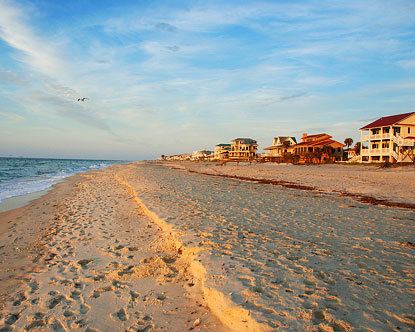Max length 45.1 km | Max width 1.6 km | |
 | ||
St. George Island is an island off the Florida Panhandle in the northern Gulf of Mexico. It is in Franklin County, Florida, United States.
Contents
- Map of St George Island Florida 32328 USA
- Physical characteristicsEdit
- HistoryEdit
- GeographyEdit
- VegetationEdit
- WildlifeEdit
- References
Map of St. George Island, Florida 32328, USA
Physical characteristicsEdit
St. George is a barrier island 28 miles (45 km) long and 1 mile (2 km) wide at its widest point. St. George Island is adjacent to Cape St. George Island, also known as Little St. George Island. It is connected to the mainland at Eastpoint, Florida by the 4-mile (6.4 km) long St. George Island Bridge over Apalachicola Bay. Nearby towns include Eastpoint, Carrabelle, and Apalachicola.
St. George Island is informally divided into three regions: the Dr. Julian G. Bruce St. George Island State Park; a public strip of restaurants, bars, small businesses, homes and public beach; and a private, gated, highly exclusive housing community with its own airstrip that includes some of the most expensive multimillion-dollar beach homes along the Gulf of Mexico.
The island is known for being quiet and tranquil due to its small size. Many occupants of the island rent out their homes during the spring and summer months. As of 2008, the island has no central sewage system and receives very little funding for road and infrastructure improvements, leading some to believe the island should form its own special taxing district. Saint George Island is said to be one of the most expensive islands on the Gulf to rent or own, and many purchase land on the island as an investment.
St. George Island State Park occupies the eastern nine miles (14 km) of the island. People can camp there as well as swim with reservations. Many fishing reservations are also available in the area. The park has a series of hiking trails, boardwalks and observation platforms. Bird watching is a popular activity there. The area is well known for its excellent variety of Apalachicola Bay and Gulf of Mexico fish and seafood including oysters, scallops, grouper, flounder, redfish, snapper, trout, mullet, and others.
HistoryEdit
St. George Island was first inhabited by the Creek Indians between the 10th and 15th centuries, who were all killed off by disease. With the arrival of European colonists to the area in the late 18th century came an intense struggle for control. In 1803, the Creek Indians ceded a large tract of land, which included St. George Island, to trader John Forbes and Company, known as the Forbes Grant.
In 1823 John Lee Williams sought refuge there. With a shortage of food supplies, his crew depended on the island’s ample store of oysters and crabs. Soon afterwards, the island experienced a surge in trading activities especially along the banks of the Apalachicola River. This led to the construction of the central lighthouse on the island in 1833. It was used in those times as a navigational tool for incoming ships. However, it was destroyed in 2005 by a storm, much to the chagrin of native islanders. The lighthouse has since been reconstructed.
During the early and mid-20th century the island's pine forest was used for turpentine production in naval stores.
During World War II, St. George Island was a practice range for B-24 bombers from nearby Apalachicola.
In 1954, the U.S. Army Corps of Engineers constructed the ship channel known as Bob Sikes Cut across St. George Island creating Cape St. George Island or "Little St. George Island" and enhanced its remoteness. The cut is used by the fishing fleet from Apalachicola and provides an access to the Gulf waters from the bayside.
GeographyEdit
The island is composed of mostly sand dunes with sea oats and pine trees. The west end of the island is known as the St George Plantation. Its over 1,200 acres (4.9 km2) with 24/7 security and accessible only to owners and their rental designees. It is quite a bit wider than the eastern portion of the island.
VegetationEdit
Scrub and sea oats can be found on the newer dunes, slash pine flatwoods in the older relic dunes. The western part of the island is more forested while the eastern two-thirds is more sparse in trees.
WildlifeEdit
St. George Island is a known nesting ground for loggerhead sea turtles. They come to the beach to lay their eggs between the months of May and October.
